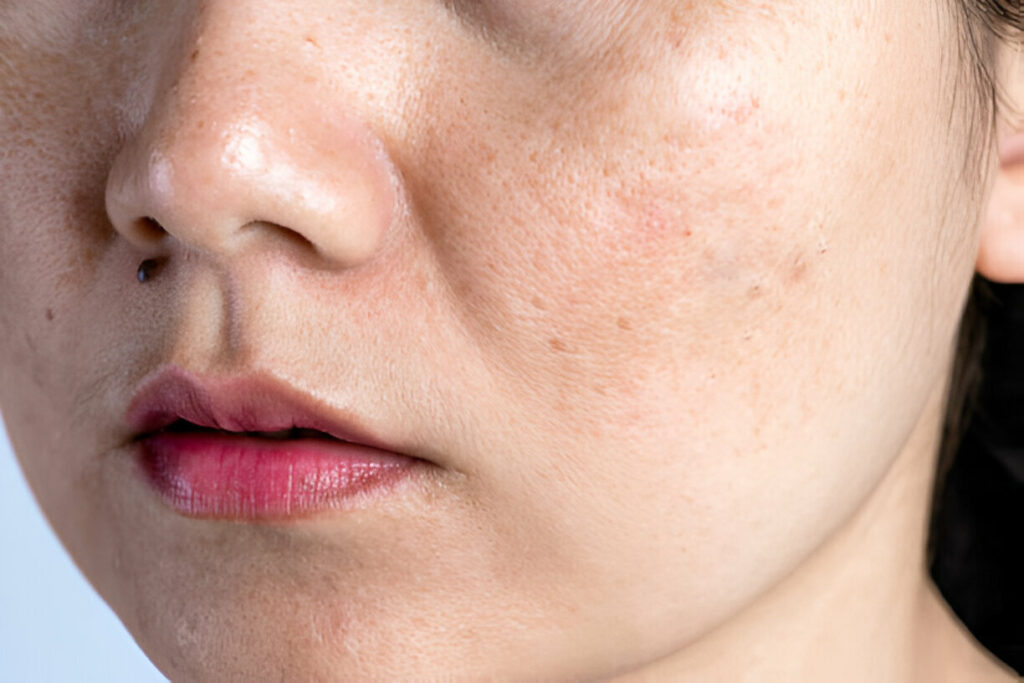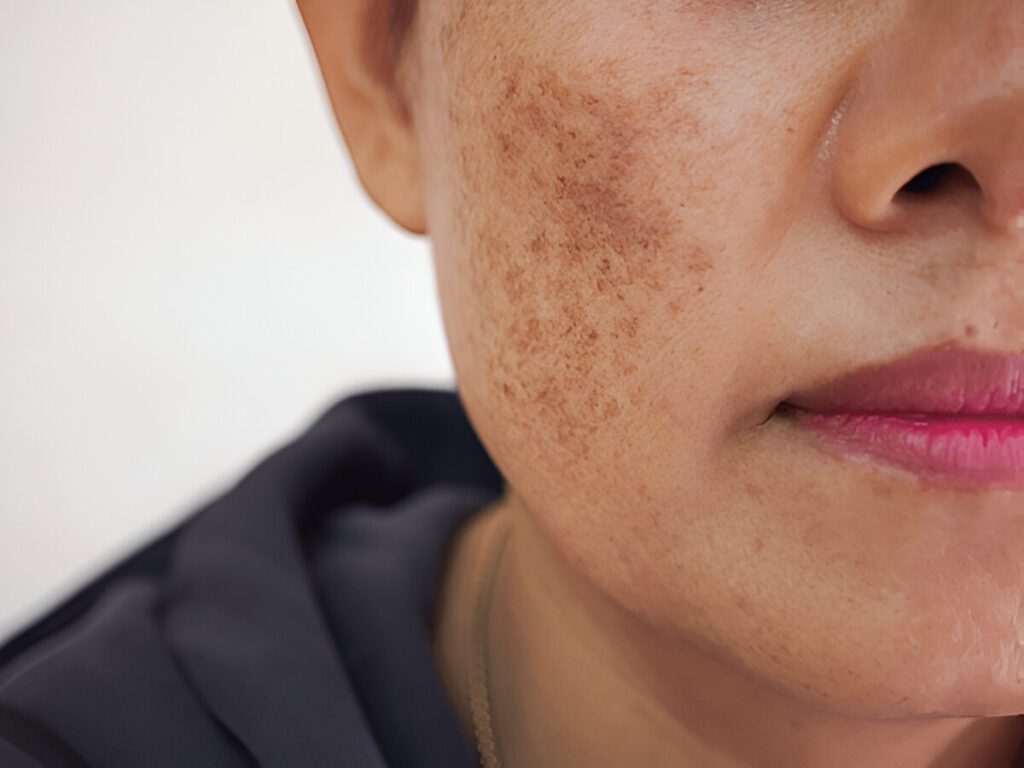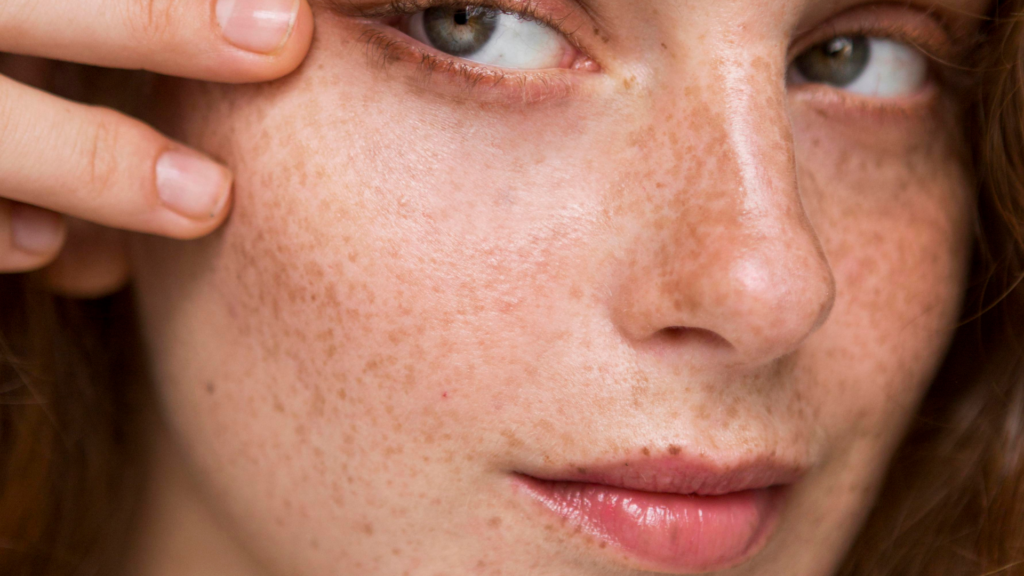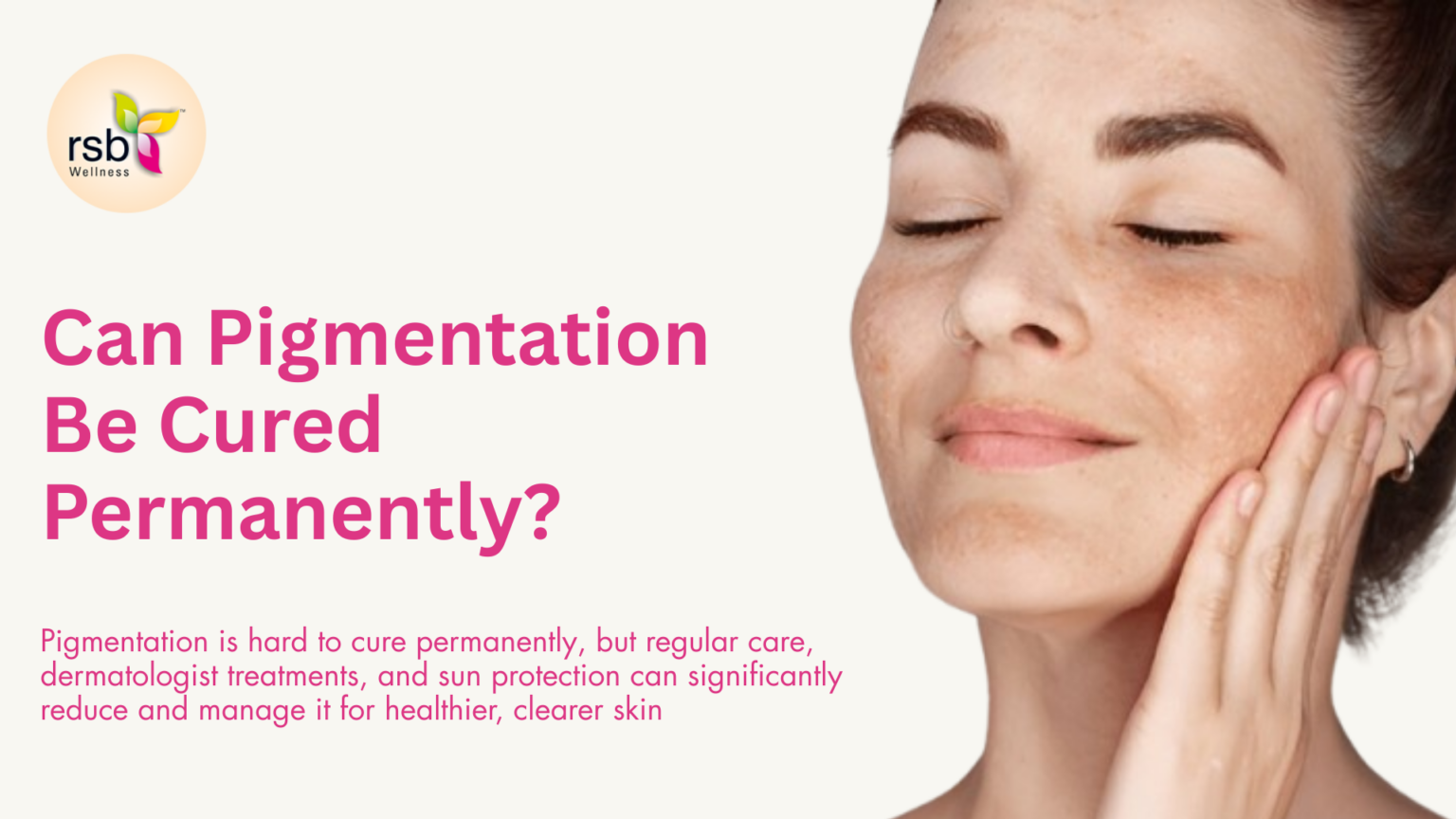Pigmentation is a very common skin concern, It can affect both men and women of all age groups. Whether it’s dark patches on your face, uneven skin tone, or spots on your face after pimples, many people are struggling with it daily.
In India, pigmentation issues are especially seen in people with medium to dark skin tones due to high sun exposure. According to reports, around 35–40% of people in India face some form of pigmentation. Globally, about 1 in 4 people over the age of 30 deal with hyperpigmentation concerns.
If you are above 25 years of age, especially women, you may experience higher pigmentation due to hormonal changes, sun damage, stress, or even PCOS. You might be wondering, can pigmentation be cured permanently? Understanding the reasons behind it and following proper care and preventive measures can help manage it effectively.
What Is Pigmentation?
Understanding the Pigmentation
Pigmentation means the natural color of your skin, hair, and eyes. This color comes from melanin, a pigment made by skin cells called melanocytes. Everyone has melanin, but the amount and type differ, which is why people have different skin tones.
Pigmentation plays a major role in protecting your skin from harmful UV rays. However, when melanin production becomes imbalanced — either too much or too little — it leads to pigmentation disorders. These can appear as dark patches (hyperpigmentation) or light patches (hypopigmentation) on your skin.
This condition affects both men and women and can occur at any age, though it’s more common in adults over 30. In India, factors like sun exposure, pollution, and hormonal issues make pigmentation a widespread concern. It’s not usually dangerous, but it can affect your confidence and skin health. Identifying the type and cause of pigmentation is the first step toward effective treatment and prevention.

Types of Skin Pigmentation Disorders
Understanding Various Pigmentation Conditions
Skin pigmentation disorders occur when melanin production in the skin becomes uneven, causing patches that may appear darker or lighter than the surrounding skin.
These conditions can affect people of all ages and genders, and are more noticeable in darker skin due to higher melanin levels. Let’s explore the forms of pigmentation:
1. Melasma
Melasma appears as irregular, brown or grey-brown patches on the cheeks, forehead, nose bridge, and upper lip. It’s often referred to as the “mask of pregnancy” due to its link with hormonal changes during pregnancy or birth control use.
Sun exposure worsens it, and it’s far more common if you’re a woman with medium to dark skin. While not harmful, it can significantly affect your confidence.
2. Post-Inflammatory Hyperpigmentation (PIH)
PIH is the skin’s natural response to injury or inflammation such as acne, eczema, cuts, or burns. It leads to flat, dark spots that stay after the original issue heals.
These marks are more noticeable and persistent if your skin is darker tones, making PIH one of the most common dark skin pigmentation disorders. Regular sunscreen use and skin-calming treatments are essential for prevention and fading.
3. Sun Spots (Lentigines)
Sun spots, also called age spots or solar lentigines, are small, flat brown or black spots that develop on you due to repeated sun exposure over the years. They most often appear on sun-exposed areas like the face, shoulders, chest, and hands, especially if you’re over 40.
While harmless, many seek treatment for cosmetic reasons using laser, peels, or brightening creams.
4. Vitiligo
Vitiligo is a long-term skin condition where pigment-producing cells (melanocytes) are destroyed, leading to white patches anywhere on the body. It may begin in small areas but can gradually expand. It affects all skin types but is more visible in darker skin.
Though not contagious or painful, it may cause emotional distress and often requires both medical and cosmetic treatment.
5. Albinism
Albinism is a rare genetic condition where the body produces little or no melanin. It affects the skin, hair, and eyes, often resulting in light-colored features and visual problems.
If you are suffering with albinism you are extremely sensitive to sun exposure and at higher risk of sunburn and skin cancers, making lifelong sun protection and routine care essential.
6. Lichen Planus Pigmentosus (LPP)
LPP is a chronic pigmentation disorder that causes dark brown to greyish-black patches, commonly on the face, neck, and upper limbs. It mainly affects individuals with medium to dark skin tones and may be triggered by sun exposure, cosmetics, or certain medications.
The discoloration is often stubborn and slow to fade, requiring long-term treatment.

Can Pigmentation Be Cured Permanently?
Is a Permanent Cure Possible for pigmentation?
Pigmentation may not always be cured permanently, as it depends on its type, symptoms, and underlying causes. However, it can be significantly reduced and effectively managed with the right treatments and consistent skincare.
Concerns like melasma, sun spots, and post-inflammatory hyperpigmentation often fade with targeted therapies, though they may recur without proper care. Long-lasting results are possible by treating the root cause, following skin care providers approved procedures, and adopting preventive measures.
Advanced treatments such as medical facials, chemical peels, laser therapies, and IV-based solutions work deeply to correct pigmentation. Alongside this, daily sunscreen use, pigment-correcting serums, and a healthy lifestyle help prevent recurrence and maintain naturally radiant skin.
Causes of Skin Pigmentation
Pigmentation occurs when the skin produces uneven melanin, resulting in dark spots, patches, or uneven tone. Several lifestyle, health, and environmental factors can trigger this, making prevention as important as treatment.
- Diet and Nutritional Deficiency: Lack of vitamins like C, E, and B-complex weakens skin repair, causing spots and dullness.
- Stress and Lifestyle Factors: Stress, poor sleep, and smoking accelerate free radical damage, making skin prone to dark patches.
- Inflammation or Skin Injuries: Acne, burns, or cuts can leave long-lasting dark marks, especially when exposed to sunlight.
- Excessive Heat or Friction: Constant rubbing on underarms, thighs, or other areas may cause localized pigmentation.
- Chemical Exposure: Harsh skincare products and bleaching agents can irritate skin and worsen pigmentation.
Symptoms of Skin Pigmentation
Pigmentation usually develops slowly, and early signs often go unnoticed. Identifying these changes early ensures timely care and better outcomes.
- Uneven Texture or Rough Patches: Areas of skin may feel slightly raised, dry, or rough, suggesting underlying melanin buildup that could later appear as visible spots.
- Blotchy Complexion: Instead of a uniform glow, the skin starts looking patchy or mottled, signaling early imbalance in pigment distribution.
- Discolored Lips or Eye Contour: Darkening around lips, eyelids, or under the eyes often points to sensitivity in delicate skin areas.
- Gradual Darkening of Scars: Acne marks, burns, or cuts can become progressively darker, especially after sun exposure, indicating post-inflammatory pigmentation.
- Spotting on Exposed Areas: Small, irregularly shaped spots may appear on the face, hands, chest, or shoulders — areas most exposed to UV rays and pollution.
Is Pigmentation a Sign of a Health Issue?
When Pigmentation Is More Than Just a Cosmetic Concern?
Yes, sometimes pigmentation is more than just a skin concern. It can signal hormonal or internal health issues, especially if it appears suddenly or spreads fast.
- PCOS (Polycystic Ovary Syndrome) – Hormonal imbalance may cause dark patches, especially around the neck and underarms.
- PCOD (Polycystic Ovarian Disease) – Hormonal fluctuations in PCOD can lead to dark patches on the skin, commonly seen around the neck, underarms, and inner thighs.
- Thyroid issues – Both hypo- and hyperthyroidism can lead to uneven skin pigmentation.
- Insulin resistance – Common in pre-diabetes and diabetes, this can lead to a condition called Acanthosis Nigricans.
- Vitamin B12 deficiency – Low levels can lead to skin discoloration or dark patches.
- Certain medications – Some antibiotics, chemotherapy, or hormonal drugs may trigger pigmentation as a side effect.
- Liver or Kidney Disorders: May rarely present with skin discoloration.
- Autoimmune Conditions: Like Addison’s disease can also cause pigmentation.
Diagnosis of Pigmentation
Important Test For Pigmentation
Accurate diagnosis is essential to treat pigmentation effectively. A skin care provider begins by examining your skin visually to understand the type, pattern, and depth of pigmentation.
This helps determine whether the issue is superficial (epidermal) or deeper (dermal). Understanding this is important because treatments vary based on how deep the pigment lies in the skin.
- Wood’s Lamp Examination: A special UV light that helps highlight the depth of pigmentation.
- Dermatoscopy: A handheld device used to examine skin patterns and color more closely.
- Skin Biopsy (in rare cases): If the pigmentation seems abnormal or resembles a mole or lesion, a small skin sample may be tested.
- Medical History Review: Doctors also ask about your sun exposure, hormonal changes, past skin conditions, or medication use that could trigger pigmentation.
- Digital Skin Analysis: Some clinics use advanced imaging to analyze skin layers and pigmentation density.
Treatments for Pigmentation
Pigmentation Removal Treatments
Dealing with pigmentation? From surface-level dark spots to deeper discoloration, there are advanced treatments designed to restore even-toned, radiant skin. Explore these top pigmentation treatments that target the root cause and deliver long-lasting, visible results.
– Medifacial for Pigmentation
If you’re getting ready for a close friend’s party or a family gathering and want an instant glow, a Medifacial can help. This treatment exfoliates, hydrates, and delivers pigment-correcting serums, reducing dark spots while improving your skin texture. It’s perfect for you if you have sensitive or dull skin, leaving you radiant and refreshed for any event.
– Glow Peel for Pigmentation
Is your cousin’s wedding coming up and you want your skin to look flawless in photos? Glow Peel for pigmentation could be the best solution for you. Using advanced exfoliating acids, it removes pigmented layers, stimulates cell renewal, and fades sunspots or post-acne marks, leaving your skin brighter, smoother, and more even-toned.
– Hydrafacial for Pigmentation
You are busy for whole week! And want your skin to look fresh and glowing for meetings or events, then you should try for Hydrafacial. It gently exfoliates, cleanses, and hydrates while delivering antioxidants, leaving your skin bright, clear, and ready for any occasion with no downtime.
– Q-Switch Laser for Pigmentation
Are stubborn freckles or deep pigmentation ruining your look before a big event or party? Q-Switch Laser for pigmentation offers a quick, non-invasive solution for you. It targets excess melanin with high-intensity laser pulses, brightening your skin and creating an even tone without affecting surrounding areas.
– Chemical Peel for Pigmentation
A Chemical Peel effectively tackles your sun damage, post-acne marks, and early signs of aging. It exfoliates your skin’s pigmented layers, stimulates new skin growth, reduces fine lines, and restores clarity and smoothness, leaving your skin refreshed, radiant, and youthful.
– Semi-Permanent Makeup for Pigmentation
Need a fast solution for resistant dark patches before a photoshoot or wedding? Semi-Permanent Makeup camouflages pigmentation using natural pigments, giving your skin a flawless, even appearance that lasts for weeks.
– Exfoliation for Pigmentation
If your skin feels dull or patchy before an important meeting or casual outing, regular exfoliation can help. Gentle scrubs or peels remove dead cells, fade superficial pigmentation, and refresh your skin, making it smoother and more radiant naturally.
– IV Glutathione for Pigmentation Treatment
You’re looking for long-term brightness from within before a big event or seasonal change, IV Glutathione is a great option. This antioxidant detoxifies your body, reduces melanin production, and gradually gives your skin a natural, healthy glow.
Get Your Free Consultation
Understand whether pigmentation goes away forever or needs long-term care
What Are the Prevention Tips for Pigmentation?
Can Pigmentation Be Cured Permanently?
Pigmentation can be stubborn and may not vanish completely, but with the right approach, it can be significantly reduced and well-controlled. The big question, Can Pigmentation Be Cured Permanently? depends on its cause and severity. While treatments and skincare play an important role, the best option is prevention—protecting your skin early ensures you won’t have to undergo extensive treatments later.
– How Do You Keep Pigmentation Away Long Term?
The key to preventing pigmentation is consistency. Protect your skin daily, avoid triggers like excessive sun, and treat inflammation or breakouts promptly to avoid dark marks later. Early intervention is crucial to stop spots from deepening.
– Role of Sunscreen and Antioxidants
Sunscreen is your skin’s best defense. UV rays are the number one cause of pigmentation. Use a broad-spectrum SPF 30 or higher, even on cloudy days or indoors. Reapply every 2–3 hours if you’re outside.
Antioxidants like Vitamin C and E protect the skin from oxidative stress, which can lead to uneven skin tone and Include antioxidant-rich serums.
– Importance of Diet and Vitamins
A balanced diet rich in Vitamin A, C, and E, zinc, and omega-3 fatty acids helps nourish your skin from within. Fruits like berries, oranges, and green veggies in your routine.
These nutrients support skin repair and reduce inflammation, a major cause of pigmentation.
Hydration is also vital, drink enough water and avoid excessive caffeine or processed foods that trigger breakouts and dullness.

Conclusion
Can Pigmentation Be Cured Permanently?
Pigmentation is a common concern affecting you in all ages and skin tones, especially in areas with high sun exposure. While permanent removal is challenging, pigmentation can be significantly reduced and controlled with the right combination of treatments and consistent skincare.
Targeted solutions such as chemical peels, laser therapies, Medifacials, Glow Peels, and IV Glutathione address stubborn dark spots, melasma, sun damage, and post-acne marks. Alongside these, preventive measures like daily sunscreen, antioxidant serums, and a balanced diet help maintain even-toned, healthy skin. Lifestyle habits, including stress management, proper sleep, and avoiding harsh chemicals, also play a key role in keeping pigmentation under control.
So, can pigmentation be cured permanently? The answer depends on its type, severity, and underlying causes. While complete elimination may not be possible, a combination of medical treatments, preventive care, and consistent daily routines can manage pigmentation effectively, reduce recurrence, and give you clearer, radiant, and healthier skin over time.
Frequently Asked Question
Common Questions on Skin Pigmentation
-
What skin type is more prone to pigmentation?
Darker skin types are more prone to pigmentation, especially post-inflammatory hyperpigmentation, due to higher melanin content. They tan easily and are more likely to develop brown marks after skin injury or inflammation.
-
Can Pigmentation Be Removed?
Pigmentation can often be reduced with treatments like, chemical peels, laser therapy, and home remedies. However, results vary, and some types may be stubborn or recur over time.
-
Can pigmentation be cured permanently?
Pigmentation can be significantly improved, but a complete and permanent cure is difficult. Treatments can lighten or remove dark spots, but recurrence is common, especially without ongoing sun protection and care.
-
How do you remove existing pigmentation?
Existing pigmentation can be treated with chemical peels, laser therapy, and microdermabrasion. Consistent sun protection and skin care provider guidance improve results.
-
How to remove hyperpigmentation permanently?
Permanent removal is challenging, but advanced treatments like lasers, IPL, and deep chemical peels can provide long-lasting results. Strict sun protection is essential to prevent recurrence.
-
Can pigmentation be cured permanently on the face?
Permanent cure of facial pigmentation is unlikely, but it can be managed and reduced with ongoing treatments and preventive measures. Maintenance and sun protection are key to minimizing recurrence.
Author
-

Radhika Gupta is the CEO and guiding force behind RSB Wellness, where she blends science-backed knowledge with a deep commitment to holistic well-being. With a clear focus on integrative care, she leads the mission to empower individuals to take control of their health through personalized, practical strategies. Passionate about education and results-driven wellness, she brings both expertise and empathy to every article and initiative.

